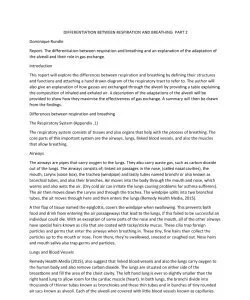DIFFERENTIATION BETWEEN RESPIRATION AND BREATHING PART 2
DIFFERENTIATION BETWEEN RESPIRATION AND BREATHING PART 2
DIFFERENTIATION BETWEEN RESPIRATION AND BREATHING PART 2
Dominique Rundle
Report: The differentiation between respiration and breathing and an explanation of the adaptation of the alveoli and their role in gas exchange.
Introduction
This report will explore the differences between respiration and breathing by defining their structures and functions and attaching a hand drawn diagram of the respiratory tract to refer to. The author will also give an explanation of how gasses are exchanged through the alveoli by providing a table explaining the composition of inhaled and exhaled air. A description of the adaptations of the alveoli will be provided to show how they maximise the effectiveness of gas exchange. A summary will then be drawn from the findings.
Differences between respiration and breathing
The Respiratory System (Appendix .1)
The respiratory system consists of tissues and also organs that help with the process of breathing. The core parts of this important system are the airways, lungs, linked blood vessels, and also the muscles that allow breathing.
Airways
The airways are pipes that carry oxygen to the lungs. They also carry waste gas, such as carbon dioxide out of the lungs. The airways consists of; linked air passages in the nose, (called nasal cavities), the mouth, Larynx (voice box), the trachea (windpipe) and lastly tubes named bronchi or also known as bronchial tubes, and also their branches. Air moves into the body through the mouth and nose, which warms and also wets the air. (Dry cold air can irritate the lungs causing problems for ast
